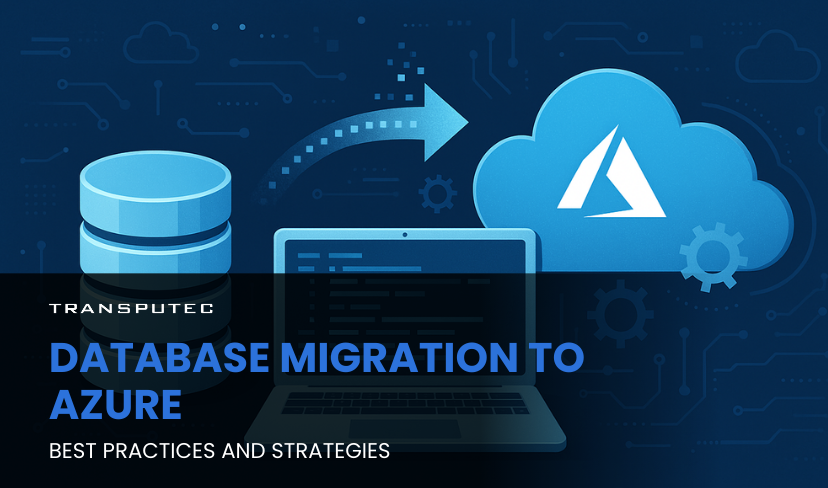Written by KRITIKA SINHA | MARKETING
Imagine a growing business where every minute of downtime means lost revenue, frustrated employees, and dissatisfied customers. Data silos slow down decision-making, legacy systems demand costly maintenance, and compliance risks lurk with every audit. For many business owners and IT leaders, these aren’t distant threats—they’re daily realities. The pressure to modernise is relentless, yet the risks of a poorly executed migration are just as daunting. This is where Database Migration to Azure emerges as a transformative solution, offering not just a technical upgrade but a path to agility, security, and future-proof growth.
In this blog, you’ll discover the key strategies and best practices for a successful Database Migration to Azure. We’ll explore the challenges businesses face, the tools and methodologies that ensure a smooth transition, and how Transputec’s expertise can help you unlock the full potential of Microsoft Azure. You’ll gain actionable insights, empirical data, and practical steps to make your migration seamless and secure
Why Database Migration to Azure is Critical Today
IDC research shows that 70% of digital transformation efforts fail due to outdated infrastructure and siloed data environments. On-premise databases often lack the agility to support cloud-native innovation, making them a bottleneck rather than a backbone.
Azure is Microsoft’s cloud computing platform, known for high availability, security, compliance, and seamless integration with tools like SQL Server, Power BI, and Azure Synapse. Database Migration to Azure gives businesses the ability to:
Scale on demand
Lower operational costs
Improve performance and uptime
Enhance data security and compliance
According to a 2023 Forrester Total Economic Impact study, migrating to Azure SQL Database led to a 238% ROI over three years with a 40% reduction in database administration effort.
Key Steps in Planning Your Database Migration to Azure
1. Assess Your Current Environment
Before starting your migration, you need to understand what you’re working with. This involves
- Take inventory of your existing databases, workloads, and applications.
- Identifying dependencies, performance issues, and custom configurations.
- Using tools like Azure Migrate or Data Migration Assistant to scan your databases and highlight potential compatibility or sizing issues.
Why this matters:
A clear understanding of your current environment helps avoid surprises later and ensures a smoother transition to Azure.
2. Define Business Objectives and Success Criteria
Every migration should be tied to a specific goal. This step involves
- Setting objectives such as cost reduction, improved performance, or increased scalability.
- Defining what a successful migration looks like (e.g., no data loss, minimal downtime, or performance improvements).
Why this matters:
Aligning technical plans with business goals ensures the migration delivers real value, not just a change in infrastructure.
3. Choose the Right Azure Service Model
Azure offers multiple hosting options, such as:
- IaaS (Infrastructure as a Service): Hosting your database on a virtual machine.
- PaaS (Platform as a Service): Using services like Azure SQL Database or Azure Database for PostgreSQL.
- Managed Instances: A middle ground with compatibility for legacy features.
Why this matters:
Selecting the right service model impacts performance, cost, and long-term management.
4. Create a Migration Strategy and Timeline
Once you’ve assessed and selected the platform, you need a detailed migration plan that includes:
- The method of migration (e.g., backup/restore, replication, or online migration).
- Downtime windows and fallback plans.
- Resource allocation and timeline.
Why this matters:
A structured timeline reduces the risk of downtime, ensures stakeholder alignment, and keeps the project on track.
5. Prepare for Security, Compliance, and Testing
Migration isn’t just about moving data. It also involves
- Setting up security policies, firewalls, and encryption in Azure.
- Ensuring compliance with industry standards (e.g., GDPR, HIPAA).
- Running multiple rounds of testing—before, during, and after migration—to validate data integrity and performance.
Why this matters:
Security and compliance are critical in today’s business environment. Thorough testing ensures nothing breaks when you go live.
Ready for a Seamless Database Migration to Azure?
Connect with us today for our free consultation!
Best Practices for Database Migration to Azure
1. Choose the Right Migration Approach
There are different ways to migrate your database, and selecting the correct one is crucial:
- Lift and Shift: Moves your database as-is to a virtual machine in Azure.
- Modernisation: Involves re-architecting or upgrading your database for cloud-native services like Azure SQL Database or Azure Cosmos DB.
- Hybrid: Combines both methods, depending on workload and criticality.
Why this matters:
Choosing the right method reduces risk, improves performance, and aligns with your long-term goals. Not every database should be treated the same—some may need reconfiguration, others a simple lift.
2. Conduct Thorough Pre-Migration Testing
Before migrating to Azure, always test:
- Data compatibility (e.g., schema, types, constraints)
- Application functionality with the new database backend
- Performance under expected loads
Use tools like SQL Server Data Tools (SSDT) and Data Migration Assistant (DMA) for this purpose.
Why this matters:
Testing prevents costly surprises post-migration. It ensures your apps and services work seamlessly with the new Azure setup, reducing the chance of downtime or data corruption.
3. Automate Where Possible
Automation speeds up repetitive tasks and improves accuracy.
- Use Azure Database Migration Service (DMS) to automate data movement.
- Automate testing, monitoring, and validation scripts to reduce manual effort.
- Script infrastructure setup with ARM templates or Terraform.
Why this matters:
Automation helps maintain consistency, lowers the chance of human error, and enables faster rollouts or rollbacks if needed.
4. Prioritise Security and Compliance
Data security must be built into your migration:
- Use Transparent Data Encryption (TDE) and Always Encrypted features.
- Set up network security groups, firewalls, and role-based access control (RBAC).
- Log activities with Azure Monitor and Defender for SQL.
Why this matters:
Security is a top concern for most businesses. Azure offers enterprise-grade tools, but they need to be configured properly. Compliance is also vital for industries like finance, healthcare, and government.
5. Minimise Downtime with a Phased Approach
You don’t need to migrate everything at once:
- Start with non-critical databases as pilots.
- Use live replication tools or Azure Site Recovery for high-availability migrations.
- Schedule cutovers during low-traffic periods.
Why this matters:
A phased rollout helps manage risk and makes it easier to isolate and fix problems. It also ensures that business operations continue with minimal interruption.
Post-Migration Optimisation Strategies
1. Monitor Performance Continuously
After migrating, it’s important to monitor how your database performs in its new Azure environment:
- Use Azure Monitor, SQL Insights, and Log Analytics to track query performance, CPU usage, and memory.
- Identify and resolve slow-running queries, missing indexes, or inefficient workloads.
Why this matters:
Initial migration doesn’t guarantee long-term performance. Continuous monitoring helps identify and resolve bottlenecks before they affect users or applications.
2. Optimise Costs Using Azure Tools
Azure charges based on resource usage, so post-migration cost optimisation is crucial:
- Use Azure Cost Management + Billing to review your consumption.
- Switch from pay-as-you-go to Reserved Instances or Auto-Scale settings for savings.
- Right-size your resources by scaling down underutilised databases or services.
Why this matters:
Cloud cost overruns are common. Optimising your Azure spend ensures you’re only paying for what you actually need.
3. Implement Advanced Security and Compliance Controls
After migrating, ensure your new environment meets the latest security and compliance standards:
- Use Azure Defender for SQL to detect threats and vulnerabilities.
- Enable auditing, encryption, and role-based access controls (RBAC).
- Review compliance against standards like GDPR, ISO 27001, or HIPAA.
Why this matters:
Security should be proactive, not reactive. Azure provides powerful tools, but they must be configured and maintained properly to stay compliant.
4. Regularly Back Up and Test Your Recovery Plans
Post-migration, your backup strategy should be modernised to suit Azure:
- Use Azure Backup or automated backup policies for databases.
- Test your disaster recovery (DR) procedures using tools like Azure Site Recovery.
- Ensure your Recovery Time Objective (RTO) and Recovery Point Objective (RPO) meet business expectations.
Why this matters:
A solid backup and recovery plan is essential. Testing your recovery process regularly ensures that you’re prepared for data loss or failure events.
5. Train Teams and Update Documentation
After migration, your IT and DevOps teams need to be familiar with Azure’s ecosystem:
- Conduct training sessions or workshops on Azure services and tools.
- Update internal documentation with new workflows, security policies, and support protocols.
- Consider ongoing managed services from providers like Transputec to support continuous improvement.
Why this matters:
Your database may be in Azure, but if your team isn’t trained to manage it effectively, you won’t realise its full value.
How Transputec Makes Database Migration to Azure Seamless
1. Expert Assessment and Custom Strategy
Transputec begins by thoroughly assessing your existing database environment—whether it’s on-premises or in another cloud. This includes:
- Evaluating database size, complexity, and dependencies
- Identifying risks and compatibility issues
- Recommending the most suitable Azure model (IaaS, PaaS, or Managed Instance)
2. End-to-End Project Management
Transputec handles the entire migration lifecycle—from initial planning to post-migration support. This includes:
- Setting clear timelines, milestones, and responsibilities
- Coordinating between technical and business teams
- Managing communications and issue resolution throughout the process
3. Minimal Downtime with Advanced Migration Tools
Transputec uses Microsoft-certified tools like Azure Database Migration Service and combines them with in-house automation to:
- Migrate data with minimal disruption
- Enable live replication or hybrid setups to avoid extended downtime
- Run pre- and post-migration testing for performance and accuracy
4. Built-In Security and Compliance Support
Security and regulatory compliance are integrated into Transputec’s migration process. This includes:
- Applying best practices in data encryption, access controls, and threat detection
- Configuring Azure tools like Defender for SQL, network firewalls, and audit logs
- Ensuring your setup meets standards like GDPR, ISO 27001, or NHS DSPT
5. Ongoing Support and Optimisation
Post-migration, Transputec doesn’t disappear. Their services continue with:
- Ongoing monitoring, cost optimisation, and performance tuning
- Helpdesk and managed support options for any issues
- Regular reviews to keep your database secure, efficient, and scalable
Conclusion: Securing Your Competitive Edge
Migrating your database to Azure is more than a technical upgrade—it’s a strategic decision that can unlock growth, agility, and cost-efficiency. From careful planning and best practices to post-migration optimization, every step matters. With expert guidance from Transputec, businesses can navigate this complex process with confidence.
Now is the time to move away from limitations and into the cloud—securely, smartly, and successfully.
Contact us today to connect with an expert and start your Database Migration to Azure journey with Transputec.

Ready to experience the Transputec difference?
Contact us today to schedule a consultation with our experts.
FAQs
1. What is the most efficient way to start Database Migration to Azure?
Begin with a thorough assessment using Azure Migrate and Data Migration Assistant. Transputec offers a guided discovery phase to map dependencies and define the best migration strategy.
2. Can Transputec handle complex migrations involving legacy databases?
Absolutely. Transputec specialises in complex scenarios, including Oracle to Azure migrations and hybrid cloud setups, using proven frameworks and automation tools.
3. Will my application experience downtime during the migration?
Minimal to zero downtime is achievable with the right strategy. Transputec implements live data replication and failover testing to ensure business continuity.
4. How does Transputec ensure data security during migration?
All data is encrypted using Microsoft-recommended protocols. Transputec runs vulnerability scans, compliance audits, and implements Azure-native security features.
5. What support is available after completing the database migration?
Post-migration, Transputec offers 24/7 monitoring, performance tuning, and cost optimisation services. Our team acts as an extension of yours, ensuring ongoing success.




